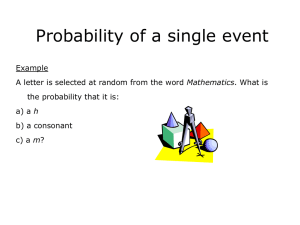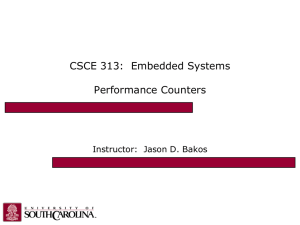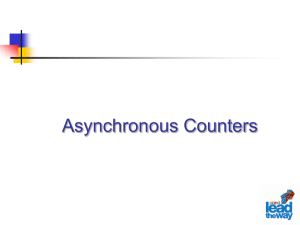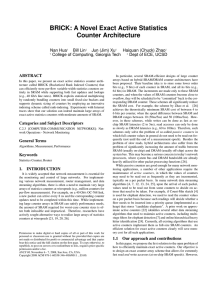BRICK: A Novel Exact Active Statistics Counter Architecture
advertisement
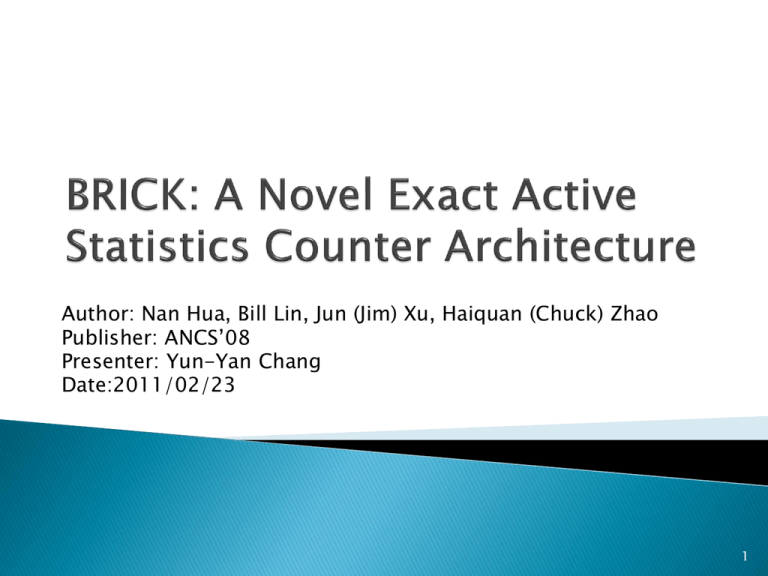
Author: Nan Hua, Bill Lin, Jun (Jim) Xu, Haiquan (Chuck) Zhao
Publisher: ANCS’08
Presenter: Yun-Yan Chang
Date:2011/02/23
1
Introduction
Design of BRICK
◦
◦
◦
◦
Basic idea
Rank indexing
Handling increment
Handling overflow
Performance evaluation
Conclusion
2
Present a novel active statistics counter
architecture called BRICK (Bucketized Bank
Indexed Counter).
BRICK
◦ Store variable width counters entirely in SRAM while
supporting fast access.
◦ Exploit statistical multiplexing technique.
Group a fixed number of randomly selected counters
into a bucket by an indexing scheme.
3
◦ Figure 1 shows the effect of statistical multiplexing
Each horizontal layer of bricks corresponds to a bucket
The length of bricks corresponds to the real counter
widths.
Figure 1: BRICK wall (conceptual baseline scheme)
4
Randomly bundle N
counters into h buckets,
B1, B2, ..., Bh, where
each bucket holds k
counters and N = hk.
Figure2: (b) Bucket structure
5
When access the yth counter,
apply the index y to permuted
index i by a permutation
function π : {1...N} →{1. . .N}.
The corresponding counter Ci
can then be found in the lth
i
bucket Bl , where l = .
k
Figure2:(a) index permutation
6
Each bucket contains p
sub-counter arrays A1,
A2, ..., Ap to store the 1st,
2nd, ..., pth sub-counters.
◦ Assume the worst-case
counter width is divided
into p parts, which refer to
as “sub-counters".
Figure 3: (a) Within a bucket, segmentation of
variable-width counters into sub-counter arrays.
7
For each counter, use indexing scheme to identify
locations of sub-counters across the different subcounter arrays.
Figure3: (b) Compact representation of variable-width counters.
8
Algorithm for get the value of ith counter.
※ rank(Ij, a): return the number of 1 in bit-string Ij,
count form Ij[1] to Ij[a].
9
Increment algorithm
※ varshift(s, j, c): bit-string s, start from jth bit, shift right c times.
10
32
※ varshift(s, j, c): bit-string s, start
from jth bit, shift right c times.
11
Extend data structure with full-size buckets F1,
F2, ... , FJ , each bucket Ft is organized as k fullsize counters.
◦ When a bucket overflow occurs for some Bl , the next
available full-size bucket Ft is allocated to store its k
counters, where t is just +1 of the last allocated full-size
bucket.
◦ Use a flag fl to set to indicate the overflowed buckets.
◦ The index of the full-size bucket Ft is stored in a field
labeled t, which is associated with Bl .
12
Memory costs and lower bounds
Sl :memory cost of each bucket
S : total memory cost
◦ Lower bound of memory
(1) lg
M
N
(2) iN1 Ci M
Ci: denote counter and counter value
M: sum of counter values
N: number of counters
13
Numerical results with various configurations
The number of entries decreases exponentially as we
go to the higher sub-counter arrays. (main compression)
14
Numerical results with various configurations
The amount of extra storage only decreases slightly
with additional levels in the BRICK implementation.
15
16
Results for real Internet trace
USC: around 18.9 million packets, 1.1 million flows.
UNC: around 32.6 million packets, 1.24 million flows.
Worst-case
counter width
Total storage requirement
USC
UNC
Naïve
25 bits/counter
3.85 MB
4.40 MB
BRICK
10 bits/counter
1.39 MB
1.63 MB
17
BRICK is SRAM-efficient yet allows for fast
counter lookup and increment.
Index filed only requires small number of
extra bits per bucket.
18







